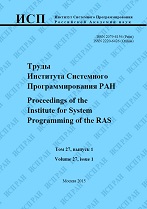|
This article is cited in 2 scientific papers (total in 2 papers)
An extended finite state machine-based approach to code coverage-directed test generation for hardware designs
I. Melnichenkoa, A. Kamkinb, S. Smolovb
a INEUM
b Institute for System Programming of the Russian Academy of Sciences
Abstract:
Model-based test generation is widely spread in functional verification of hardware designs. The extended finite state machine (EFSM) is known to be a powerful formalism for modelling digital hardware. As opposed to conventional finite state machines, EFSM models separate datapath and control, which makes it possible to represent systems in a more compact way and, in a sense, reduces the risk of state explosion during verification. However, EFSM state graph traversal problem seems to be nontrivial because of guard conditions that enable model transitions. In this paper, a new EFSM-based test generation approach is proposed and compared with the existing solutions. It combines random walk on a state graph and directed search of feasible paths. The first phase allows covering “easy-to-fire” transitions. The second one is aimed at “hard-to-fire” cases; the algorithm tries to build a path that enables a given transition; it is carried out by analyzing control and data dependencies and applying symbolic execution techniques. Experiments show that the suggested approach provides better transition coverage with shorter test sequences comparing to the known methods and achieves a high level of code coverage in terms of statements and branches. Out future plans include some optimizations aimed at method’s applicability to industrial hardware designs.
Keywords:
hardware design, hardware description language, simulation-based verification, test generation, modelling, extended finite state machine, graph traversal, random walk, backjumping, symbolic execution, constraint solving.
Citation:
I. Melnichenko, A. Kamkin, S. Smolov, “An extended finite state machine-based approach to code coverage-directed test generation for hardware designs”, Proceedings of ISP RAS, 27:3 (2015), 161–182
Linking options:
https://www.mathnet.ru/eng/tisp144 https://www.mathnet.ru/eng/tisp/v27/i3/p161
|

| Statistics & downloads: |
| Abstract page: | 170 | | Full-text PDF : | 138 | | References: | 30 |
|




 Contact us:
Contact us: Terms of Use
Terms of Use
 Registration to the website
Registration to the website Logotypes
Logotypes








 Citation in format
Citation in format 
